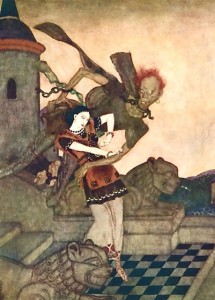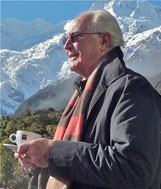Was it the feet or the meter? The feet—but even more the shoes: each long enough for six-inch toes, shiny, scaly, metallic, articulated, more like alligator tails at the end of his legs than anything else, and plainly the work of some medieval armorer banging away at an anvil in a forge.
In fact Le Guillerm’s whole impression is medieval. The acoustic lions roaring in his tent at the outset suggest the circus; but the shoes and their crashing rhythm and the darkness of the stage and the mad intensity of the man himself—jongleur, sword swallower, prestigidator, constructor, athlete, acrobat, escape artist, (whose repertoire of vocal utterances includes only a reptilian hissing “kaaaaaaaaa” from the back of the throat) more strongly suggest a deranged dungeon-keeper in Transylvania. A bullwhip with a hook on the handle helped.
 There was derangement in the eyes. They shone with obsession. “Stand back,” they said, “inside this apparently innocuous canvas tent life is not what it seems.” The punk torture-chamber look of chainmail and bondage was vaguely Bashtchelik, a creature from a Serbian folk tale. In the story, Bashtchelik is confined like Prometheus, and once released will do dreadful things… “a man bound by all the bonds of the universe, his legs encircled with rusted bands of iron, his hips and loins bound with lead, with a copper girdle at his breast and a silver band enthralling his tongue and hands.” (The image at left shows Bashtchelik as imagined by Edmund Dulac.)
There was derangement in the eyes. They shone with obsession. “Stand back,” they said, “inside this apparently innocuous canvas tent life is not what it seems.” The punk torture-chamber look of chainmail and bondage was vaguely Bashtchelik, a creature from a Serbian folk tale. In the story, Bashtchelik is confined like Prometheus, and once released will do dreadful things… “a man bound by all the bonds of the universe, his legs encircled with rusted bands of iron, his hips and loins bound with lead, with a copper girdle at his breast and a silver band enthralling his tongue and hands.” (The image at left shows Bashtchelik as imagined by Edmund Dulac.)
But to the matter of meter. Or sound in the ear. In the opening scenes Le Guillerm’s steel shoes had a distinctive thunderous rhythm. It was not an accidental effect. But were the deliberate striding crashes about the wooden stage iambic trimeters, anapaests, or what? If anapaests then there should have been two milder thumping footsteps followed by a crash; if iambic a single softer footfall and then the sound of the whole metal shoe uncoiling down to the lash of steel on the floor. Heavy cracks of the whip added menace. Once heard—never forgotten. His whip differed from the usual lion tamer’s weapon where the agon is between man and beast. Here the agon was between man and audience. The whip was meant for us. Lissen up, it said, and we did.
In Sydney recently for the 2008 Sydney Festival, Le Guillerm’s remarkable one-man circus show called “Secret” is an ensemble of astonishing pieces, and how they’re done is certainly mysterious—from the punctuative crashing of his opening act, to the gravely measured drama of the balancing books, to the spellbinding ingenuity of a massive plank and rope spiral tower at the end, this last being something that would impress Buckminster Fuller: “tensegrity” is partly what it’s about. As theatre, Le Guillerm’s performance travels intellectually from the physical to the mental; from the sensationally ominous to the cerebral muscularity of the close. Not to be overlooked is the music of Mathieu Werchowski and Guy Ajaguin. It’s as sharply original as everything else, and deepens the mad-punk-medieval mystery. Go. Catch Le Guillerm wherever he is. Even in Transylvania.

 An Australian writer living in Sydney, Roger Sandall is the author of The Culture Cult (2001), a study of romantic primitivism and its effects. His work has appeared in a number of places including Commentary, The American Interest, Encounter, The New Criterion, The American, Sight and Sound, Quadrant, Art International, The New Lugano Review, The Salisbury Review, Merkur, Mankind, Visual Anthropology, and Social Science and Modern Society.
An Australian writer living in Sydney, Roger Sandall is the author of The Culture Cult (2001), a study of romantic primitivism and its effects. His work has appeared in a number of places including Commentary, The American Interest, Encounter, The New Criterion, The American, Sight and Sound, Quadrant, Art International, The New Lugano Review, The Salisbury Review, Merkur, Mankind, Visual Anthropology, and Social Science and Modern Society.